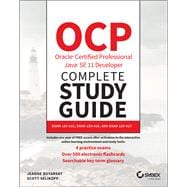This OCP Oracle Certified Professional Java SE 11 Developer Complete Study Guide was published before Oracle announced major changes to its OCP certification program and the release of the new Developer 1Z0-819 exam. No matter the changes, rest assured this Study Guide covers everything you need to prepare for and take the exam.
NOTE: The OCP Java SE 11 Programmer I Exam 1Z0-815 and Programmer II Exam 1Z0-816 have been retired (as of October 1, 2020), and Oracle has released a new Developer Exam 1Z0-819 to replace the previous exams. The Upgrade Exam 1Z0-817 remains the same.
This is the most comprehensive prep guide available for the OCP Oracle Certified Professional Java SE 11 Developer certification—it covers Exam 1Z0-819 and the Upgrade Exam 1Z0-817 (as well as the retired Programmer I Exam 1Z0-815 and Programmer II Exam 1Z0-816)!
Java is widely-used for backend cloud applications, Software as a Service applications (SAAS), and is the principal language used to develop Android applications. This object-oriented programming language is designed to run on all platforms that support Java without the need for recompilation. Oracle Java Programmer certification is highly valued by employers throughout the technology industry.
The OCP Oracle Certified Professional Java SE 11 Developer Complete Study Guide in an indispensable resource for anyone preparing for the certification exam. This fully up-to-date guide covers 100% of exam objectives for Exam 1Z0-819 and Upgrade Exam 1Z0-817 (in addition to the previous Exam 1Z0-815 and Exam 1Z0-816). In-depth chapters present clear, comprehensive coverage of the functional-programming knowledge necessary to succeed. Each chapter clarifies complex material while reinforcing your understanding of vital exam topics. Also included is access to Sybex's superior online interactive learning environment and test bank that includes self-assessment tests, chapter tests, bonus practice exam questions, electronic flashcards, and a searchable glossary of important terms. The ultimate study aid for the challenging OCP exams, this popular guide:
- Helps you master the changes in depth, difficultly, and new module topics of the latest OCP exams
- Covers all exam objectives such as Java arrays, primitive data types, string APIs, objects and classes, operators and decision constructs, and applying encapsulation
- Allows developers to catch up on all of the newest Java material like lambda expressions, streams, concurrency, annotations, generics, and modules
- Provides practical methods for building Java applications, handling exceptions, programming through interfaces, secure coding in Java SE, and more
- Enables you to gain the information, understanding, and practice you need to pass the OCP exams
The OCP Oracle Certified Professional Java SE 11 Developer Complete Study Guide is a must-have book for certification candidates needing to pass these challenging exams, as well as junior- to senior-level developers who use Java as their primary programming language.








